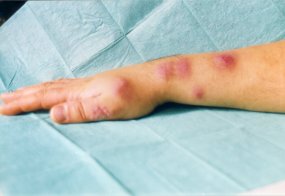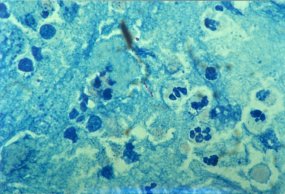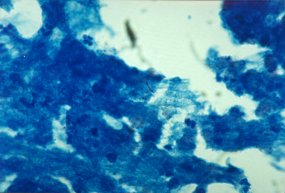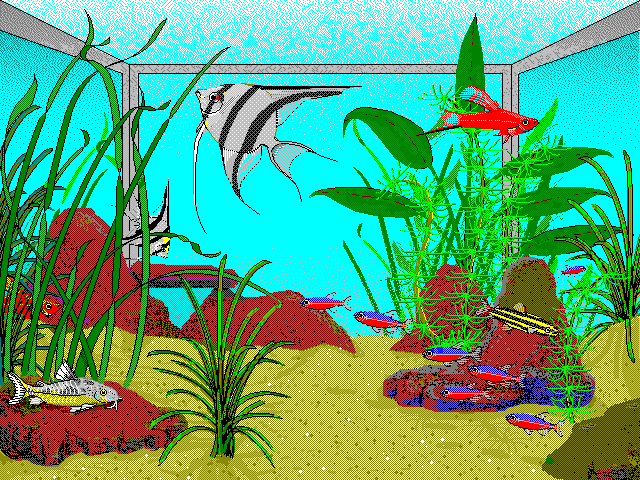
MYCOBACTERIUM MARINUM
"Giusto oggi ho incontrato un mio amico
negoziante che mi ha confermato che i "bubboni" che ha sulla mano se li è
beccati dai pesci! Non abbiamo potuto parlarne perchè aveva il negozio pieno di gente e
mi ha fatto capire che non desiderava trattare l'argomento davanti ai suoi clienti.
Una ventina di anni fa, ho conosciuto un altro negoziante che aveva manifestazioni simili
e la causa fu determinata come un ceppo di Mycobacterium, solitamente esclusivo di pesci
marini: l'ho frequentato per anni, ma, nonostante le cure, i segni dell'infezione sulla
mano e sull'avambraccio rimanevano sempre evidenti.
Dopo che avrò parlato con il mio amico negoziante, potrò fornire qualche altra notizia.
Ho il vago ricordo di aver letto anche un'articolo in proposito (forse su un vecchio
numero di Aquarium ?).
Saranno solo casi sporadici queste infezioni, ma di sicuro fino ad adesso ci è andata
bene! :-)"
Dal Congresso dell'AMCLI
Associazione microbiologi clinici italiani-Rimini 12-15 settembre 2000:
++++++++++++++++++++++++++++++++++++++++++++++++++++++++++++++++++++++++++++++++++++++++++++++++++++++++++
RAPIDO ISOLAMENTO DI MYCOBACTERIUM MARINUM IN UN CASO DI GRANULOMA DELL'ACQUARIO
(FISH TANK GRANULOMA)
Fioroni A.M.*, Brandani M., Japadre N. †, Bruno G.*
*Laboratorio analisi chimico cliniche e microbiologiche † Reparto di Malattie
infettive -Ospedale San Salvatore, L'Aquila
Nell'autunno del 1999 perveniva al settore di batteriologia del nostro laboratorio,
proveniente dal reparto Malattie infettive, un campione di fluido purulento da lesioni
della mano e del braccio che in origine papulo-nodulari, si erano con il tempo indurite e
quindi colliquate con fuoriuscita di pus.

All'anamnesi il paziente di 30 anni riferiva una precedente lesione di tipo eczematoso e
frequenti contatti con l'acqua dell'acquario di casa.

Quest'indicazione ci faceva indirizzare verso una coltura supplementare del materiale direttamente su tubi Lowenstein-Jensen, senza decontaminazione e osservazione dello stesso dopo colorazione di Ziehl-Neelsen. Alla colorazione apparivano su un fondo di cellule infiammatorie dei rari bastoncelli ZN positivi.


L'incubazione dei tubi al buio sia a 30°C sia a 37°C portava ad evidenziare dopo appena cinque giorni delle piccolissime colonie biancastre. Dopo un'altra settimana, le colonie ben visibili erano esposte alla luce ambiente e dopo appena due ore assumevano un colore giallo brillante che con il tempo si accentuava.Il ceppo di questi micobatteri chiaramente fotocromogeni inviato al laboratorio di Microbiologia dell'Ospedale Careggi di Firenze e tipizzato mediante HPLC degli acidi micolici estratti, era identificato come Mycobacterium marinum. Il ceppo era sensibile al solo etambutolo (2µg/mL), resistente all'isoniazide, rifampicina, PAS, streptomicina. Dopo sei mesi di terapia con claritromicina 500 mg x2 , le lesioni nodulari simil sporotrichoidi erano guarite residuando solo zone pigmentate , mentre solo in zona ascellare rimaneva un piccolo nodulo in fase di guarigione (foto documentanti).

Grazie alla storia completa del paziente e alla stretta collaborazione fra clinica e
laboratorio, si è fatta una rapida e completa diagnosi d'infezione cutanea da
micobatterio atipico. Il nostro ceppo aveva la particolarità di crescere anche a 37°C e
di avere una spiccata positività alla colorazione di ZN, soprattutto dopo esposizione
delle colonie alla luce. Cio' puo' essere dovuto al fatto che la produzione di pigmenti
carotenoidi foto-indotta rende piu' resistente la membrana micobatterica alla
decolorazione con alcool- acido. Secondo vari studi quest'infezione è sotto diagnosticata
.In Francia si parla di almeno un caso ogni 50 casi di TBC descritta
batteriologicamente. Come tutti i micobatteri atipici anche M. marinum è molto resistente
agli agenti antitubercolari preferendosi nella pratica clinica i macrolidi.
+++++++++++++++++++++++++++++++++++++++++++++++++++++++++++++++++++++++++++++++++++++++++++++++++++++++++++
MICRORGANISMI DI RARO RISCONTRO: DESCRIZIONE DI UN CASO DI MICOBATTERIOSI CUTANEA DA
MYCOBACTERIUM MARINUM NEL NORD-SARDEGNA
Castiglia N., Lorenzoni A.°, Molicotti P.*, Satta S.°, Cherchi G.B.
Laboratorio Analisi OORR - A.USL n. 1 Sassari, °Divisione di Dermatologia OORR - A. USL
n. 1 Sassari, *Dipart. Scienze Biomediche Sez. di
Microbiologia Sperim. e Clinica - Università degli Studi Sassari
OBIETTIVI SPECIFICI: vogliamo in questo lavoro
segnalare un caso di micobatteriosi cutanea da M. marinum da noi isolato nel
febbraio del 2000; tale patologia, sinora rara nella nostra regione, potrebbe essere
attualmente sottostimata e comunque potenzialmente destinata ad assumere un maggiore
rilievo nel corso dei prossimi anni. Scopo dell'indagine è descrivere il caso da noi
osservato correlandolo con alcune osservazioni sulla diagnosi clinica e microbiologica.
MATERIALI E METODI: una giovane donna immunocompetente ricoverata presso il Reparto
Dermatologico degli OORR di Sassari per delle lesioni sporotricoidi granulomatose
suppuranti alla mano ed all'avambraccio sn. riferiva all'anamnesi di essersi occupata
della pulizia di un acquario tropicale nei mesi precedenti l'insorgenza della prima
lesione subungueale all'indice della mano sn.; l'aspetto delle lesioni ed il dato
anamnestico suggerivano al responsabile del reparto la richiesta di accertamenti colturali
mirati all'identificazione del M. marinum; il prelievo è stato effettuato
mediante aspirazione con siringa priva di ago dopo spremitura di una formazione
granulomatosa. Il materiale siero-purulento è stato trattato come segue: diluizione in
fisiologica sterile, breve passaggio in vortex,
decontaminazione frazionata con diversi tempi di contatto, successiva centrifugazione e
semina in terreno di Lowenstein-Jensen della ditta BBL, incubazione in termostato a 22°,
30° e 37° C.
RISULTATI: l'osservazione microscopica del campione non permetteva di rilevare la presenza
di germi acido-alcool resistenti o fluorescenti all'auramina. Dopo circa 12 giorni di
incubazione si rilevava una iniziale debole crescita di alcune colonie lisce color crema
nel terreno incubato a 30°C ed al 15° si osservava sui vetrini la presenza di
caratteristici bacilli acido-alcool resistenti intensamente fluorescenti all'auramina.
L'identificazione tramite prove biochimiche e PCR ha confermato l'iniziale sospetto
diagnostico di micobatteriosi cutanea da M.marinum.
CONCLUSIONI: tra le micobatteriosi atipiche quella da M. marinum rappresenta un
caso di raro riscontro laboratoristico nella nostra isola; ciò può essere dovuto ad una
scarsa ricerca mirata di tale organismo ed a una non perfetta collaborazione dei medici
curanti con il Laboratorio di Microbiologia. La frequente paucibacillarità a livello di
lesione e le sue esigenze di temperatura di crescita possono ridurre ulteriormente il
numero di identificazioni o non consentirle affatto a temperature diverse.

INFEZIONI NEI FREQUENTATORI DI PISCINE
(RIPORTO QUESTO DOCUMENTO TROVATO SU INTERNET)
| Elsewhere on this newsgroup, there is an ongoing debate concerning
the threat posed to swimmers by "poopy diapers" and other sources of potential
pathogenic microorganisms. My position is that the threat of serious illness (otitis
externa and tinea pedis considered to be well known risks which are generally not
considered to be "serious") from swimming in most pools is very remote, based on
personal experience and observation. Most health related debates benefit from an understanding of the existing medical literature on the topic. Therefore, I performed a PubMed search, using the following search syntax: (infection* [titl] OR illness* [titl] OR viral* [titl] OR bacterial* [titl]) AND swim* [titl] AND pool* [titl] This resulted in the retrieval shown below. Of interest is that the majority of studies were in non-English journals (virtually all important studies are published in English, even when carried out in non-English speaking countries). Of relevance to the "poopy diaper" debate (and serving as an interesting window on medical inquiry in the former Soviet Union) was the study abstracted below in which a swimming pool in Russia was intentionally infected with e coli containing a genetic marker, followed by having a group of kindergarten children swim in the infected pool to determine what percent of them would develop colonization with the e coli containing the marker (turned out that 10% of them did). - Larry Weisenthal Huntington Beach, CA >>> Public Health 1999 Sep;113(5):227-232 Risk of infection associated with microbiological quality of public swimming pools in Bologna, Italy. Leoni E, Legnani P, Guberti E, Masotti A Department of Medicine and Public Health, University of Bologna, Italy. Twelve public swimming pools in Bologna (Emilia-Romagna region, Italy) were investigated for the microbiological quality of water and surfaces of the pool edges, showers and changing rooms. At the same time a cross-sectional study was carried out on the health of 238 users (bathers) compared with 238 controls who practised sports other than swimming. Data regarding duration and frequency of exposure, behaviour and recent medical history were gathered by means of a questionnaire. All participants also underwent a medical examination. Compliance of the pool water to the microbiological standards set by Italian regulations was generally good; compliance was total when free chlorine residual was within the recommended limits. However, when analysis was extended to the various surfaces, potentially pathogenic bacteria such as P. aeruginosa and C. albicans were isolated. Eye burning and diarrhoea were the only declared symptoms and verrucas the only diagnosed disease showing statistically significant differences between bathers and controls. Verrucas tended to increase in proportion to exposure. Athlete's foot had a very high prevalence among both bathers (34&percnt) and controls (27.3%) and controls (27%). The environmental and epidemiological investigations both confirmed the risk of infection, mainly associated with the contamination of surfaces. ---------- Commun Dis Rep CDR Rev 1996 Feb 2;6(2):R37-40 Managing swimming, spa, and other pools to prevent infection. Dadswell JV Silchester, Reading. Many different kinds of recreational and therapeutic pools now exist and all have the potential to transmit infection. This paper offers a brief review of reports of pool associated infections, along with short descriptions of the different kinds of pool and of the disinfection and filtration systems designed to minimise the possible transmission of infection by pool water. An outline of pool monitoring is included together with the rationale of microbiological testing and current microbiological guidelines. Good management is important; a well managed pool with an adequate disinfectant level, a pH value within the recommended range, regular filter backwashing, and satisfactory microbiological parameters will not present a significant infection risk. If management or design is poor, conditions can occur in which bathers become infected. Most infections reported in association with pools happen in these circumstances. ---- JAMA 1994 Sep 28;272(12):914-5 From the Centers for Disease Control and Prevention. Cryptosporidium infections associated with swimming pools--Dane County, Wisconsin, 1993. ---------- MMWR Morb Mortal Wkly Rep 1994 Aug 12;43(31):561-3 Cryptosporidium infections associated with swimming pools--Dane County, Wisconsin, 1993. In March and April 1993, an outbreak of cryptosporidiosis in Milwaukee resulted in diarrheal illness in an estimated 403,000 persons (1). Following that outbreak, testing for Cryptosporidium in persons with diarrhea increased substantially in some areas of Wisconsin; by August 1, 1993, three of six clinical laboratories in Dane County were testing routinely for Cryptosporidium as part of ova and parasite examinations. In late August 1993, the Madison Department of Public Health and the Dane County Public Health Division identified two clusters of persons with laboratory-confirmed Cryptosporidium infection in Dane County (approximately 80 miles west of Milwaukee). This report summarizes the outbreak investigations. --------- J Public Health Med 1994 Jun;16(2):145-8 A community outbreak of echovirus infection associated with an outdoor swimming pool. Kee F, McElroy G, Stewart D, Coyle P, Watson J Department of Public Health Medicine, Northern Health and Social Services Board, Ballymena. Forty-six people became ill with vomiting, diarrhoea and headache within days of an outdoor swimming pool opening for the summer season in a small seaside village. During the weekend of the outbreak, 185 tickets to the pool had been sold. It was found that 34 bathers were ill, and one subject had vomited into the pool. All other cases arose after this incident. The risk of infection was greatest among those who swallowed pool water (24/28 versus 10/17, p = 0.07). Echovirus 30 was isolated from the case who vomited into the pool and from six other cases. Normal chlorine levels had not been adequate to contain the infection risk from vomitus, and, in future, pool attendants witnessing such incidents should consider closing the pool to the public and seeking advice on superchlorination. --------- Bol Asoc Med P R 1991 May;83(5):181-4 Dermatophyte feet infection among students enrolled in swimming courses at a university pool. Bolanos B Department of Microbiology and Medical Zoology, University of Puerto Rico, San Juan. The aim of this study was to determine the prevalence of dermatophyte feet infection among students enrolled in swimming courses at a university swimming pool. Tinea pedis infection was determined on two occasions. The first study took place on the first day of classes and the second on day twelve of swimming lessons. Culture and KOH examination of the interdigital skin scrapings of the left foot showed superficial foot infection with dermatophytes or Candida albicans in 13.2% of the students (11/83) in the first study, and in 22.2% of the students (16/72) in the second study. The most common agent of tinea pedis in the first study was Trichophyton rubrum (82%), infections by T. mentagrophytes (9%) and Epidermophyton floccosum (9%) were less common. At that time, no dermatophyte was recovered from any of 30 floor samples taken from the bathroom and pool facilities. In the second study the following dermatophytes were isolated from the student's feet: T. mentagrophytes (70.6%), T. rubrum (17.6%) and Candida albicans (11.8%). On this occasion T. mentagrophytes was recovered from 5 out of 30 floor samples. It is possible that the frequency of the use of the pool facilities may influence the prevalence of tinea pedis as well as the etiological agent involved in this disease. ---------- Ann Dermatol Venereol 1991;118(12):973-7 [Infections and skin diseases acquired in swimming pools]. [Article in French] el Baze P, Ortonne JP Laboratoire de Bacteriologie, Hopital Pasteur, Nice. ---------- Duodecim 1991;107(17):1437-40 [Swimming pool granuloma: hand infection caused by Mycobacterium marinum]. [Article in Finnish] Kariniemi AL, Brander E, Huttunen R HYKS:n ihotautien klinikka, Helsinki. ---------- Cah Anesthesiol 1990 Dec;38(6):435-6 [Pulmonary infection by Aeromonas hydrophila following drowning in a swimming pool]. [Article in French] Lecler O, Pourriat JL, Hoang P, Fournier JL, Cupa M Departement d'Anesthesie Reanimation, CHU Avicenne-Jean Verdier, Universite Paris XIII, Bobigny, France. --------- Vrach Delo 1989 Sep;(9):112-4 [The role of swimming pools in the spread of intestinal infections]. [Article in Russian] Bondarenko VI, Iashchenko KV, Zadorozhnaia VI, Bellavina GS A kindergarten swimming bath was experimentally infested with M-17 Bacillus coli. It was found that after bathing 10% of children showed Escherichia M-17 in the feces. It is concluded that presence of conditionally pathogenic microorganisms in the water of swimming baths may be considered a qualitative and quantitative criterion of epidemic risk during bathing in infected basins in case hygienic norms are not observed per person. ---------- Zentralbl Bakteriol Mikrobiol Hyg [B] 1988 May;186(2):118-37 [Illnesses in relation to swimming pool visits--conclusions of a survey]. [Article in German] Botzenhart K, Kampe AA, Streib R Universitat Tubingen, Abteilung Allgemeine Hygiene und Umwelthygiene. Diseases acquired by using swimming-pools were recorded by inquiring visitors and local physicians in a German spa. The diseases were brought into relation with microbiological and chemical parameters of the swimming-pool water. Water quality was in general satisfying, but on days with a very great number of visitors the treatment-plant quickly was working beyond capacity. 663 out of 1056 visitors indicated diseases which they traced back to the visit of the swimming-pool. The quality of the water was the reason for only a part of the diseases. Eye-irritations and colds counted up to nearly half of the illnesses, other frequent complaints concerned the skin and the ear-nose-and throat-region. ------- Ugeskr Laeger 1988 Feb 29;150(9):551-3 [Skin infection with atypical Mycobacteria. Swimming pool/aquarium granuloma]. [Article in Danish] Esmann J, Christiansen JV --------- South Med J 1987 Jun;80(6):712-5 Community outbreak of adenovirus type 7a infections associated with a swimming pool. Turner M, Istre GR, Beauchamp H, Baum M, Arnold S In July 1982, an outbreak of pharyngitis caused by adenovirus type 7a occurred among children in a small town in western Oklahoma. Predominant symptoms were fever and sore throat (by case definition), headache (83%), abdominal pain (64%), and conjunctivitis (51%). At least 77 persons were identified whose symptoms met the case definition for illness. Onsets of illness peaked during the week of July 5 to 12, and the outbreak resolved within three weeks. A systematic telephone survey of the town revealed that persons who had swum at the community swimming pool were more likely to be ill than those who had not (P less than .001). A second survey of families with season passes to the pool showed that among swimmers, illness was directly related to average number of hours of exposure to the pool each week (P less than .001 by chi-square for trend). In addition, swimmers who reported swallowing pool water were more likely to be ill (29 of 56, 52%) than persons who did not (ten of 41, 24%) (P = .01). Throat-swab specimens from five of seven ill persons (71%) grew adenovirus 7a compared with one of 12 well persons (8%) (P = .01). The pool chlorinator had reportedly malfunctioned during early July. The outbreak resolved with proper operation of the chlorination system. Swimming pools continue to be a potential source of community-wide outbreaks of adenovirus infections. ---------- Hautarzt 1984 Jul;35(7):373-6 [Swimming pool granuloma--an atypical mycobacterial infection]. [Article in German] Niedecken HW After an introduction on the problem of swimming pool or fish tank granulomas--chronic granulomatous skin infections with Mycobacterium marinum--we present two of our own cases. The disease is discussed and the signs and symptoms, histological changes, and therapeutic methodology presented. --------- Z Hautkr 1981 Jan 1;56(1):16-8 ["Swimming-pool granuloma"--an infection of skin with mycobacterium marinum]. [Article in German] Junger H, Witzani R A typical case of infection with Mycobacterium marinum is demonstrated. Mycobacterium marinum, the symptoms and signs of infection and the way of treatment are shown. ---------- Health Lab Sci 1978 Jan;15(1):50-7 Pseudomonas aeruginosa in swimming pools related to the incidence of otitis externa infection. Seyfried PL, Fraser DJ A study is reported which demonstrates that four out of twenty-four people developed otitis externa as a result of swimming in a pool with a high incidence of Pseudomonas aeruginosa. Serotyping and phage typing were used to establish that P. aeruginosa was the etiolgoical event responsible for the outbreaks of the infection. ---------- Soz Praventivmed 1976 Jul-Aug;21(4):120-1 [Infections transmitted in swimming pools]. [Article in French] von Suzani C, Hazeghi P Public swimmingpools can be the source of infections due to micro-organism such as mycobacterium balnei, adeno and enteroviruses, the virus of plantar warts and molluscum contagiosum, the TRIC-Agent of swimmingpool-conjonctivitis and pathogenic fungi. The transmission of trichomonas vaginalis is considered unlikely-Water of pools, supposed to present satisfactory qualities by standard controls, was found to contain pathogenic staphylococci and pseudomonas aeruginosa. Effective preventive measures include the continuous recording of the redox-potential of the water, limiting the number of visitors to pool design specifications, better desinfection of sanitary installations, regular maintenance of technical equipment including frequent backwashing of filters and exclusion of visitors with communicable disease. ---------- Rocz Panstw Zakl Hig 1976;27(1):71-81 [Bacterial flora of water in indoor swimming pools]. [Article in Polish] Haman S --------- Rocz Panstw Zakl Hig 1975;26(6):675-82 [Bacterial indices of water pollution in swimming pools with reference to various methods of water disinfection]. [Article in Polish] Haman S -------- Immun Infekt 1973 Oct;1(1):22-5 [Trichomonas vaginalis infections due to use of public swimming pools]. [Article in German] Piekarski G, Saathoff M --------- Ann Ist Super Sanita 1970;6(1):1-8 [Comparative study on bacterial water pollution tests in swimming pools]. [Article in Italian] Villa L, Zaffino C ------- J Trop Med Hyg 1968 Jan;71(1):18-9 A new suggestion. Artificial plastic swimming pools as prophylactic measures against infection with schistosomiasis in developing countries. Abd-Rabbo H ---------- Nuovi Ann Ig Microbiol 1967 Nov-Dec;18(6):456-67 [Epidemiologic research on enteritogenic infections in the town of Bari. II. Study on the hygienic conditions of water in the swimming pools]. [Article in Italian] Pire E -------- Pediatria (Bucur) 1967 Jul-Aug;16(4):319-23 [Epidemiological and serological studies of a swimming-pool focus of adenoviral infections]. [Article in Romanian] Cazacu E, Busuioc C, Stoicescu A, Ionescu V, Pompilian M, Mihailescu N |